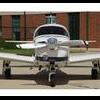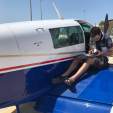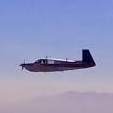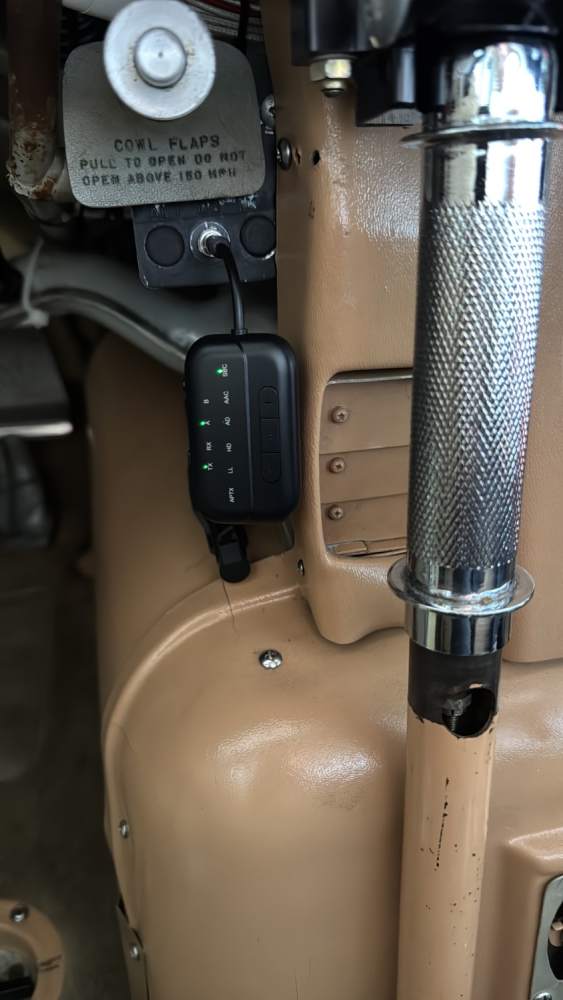All Activity
- Past hour
-

Center (above Gear well) Fresh Air Vent in M20F
TaildraggerPilot replied to Echo's topic in Vintage Mooneys (pre-J models)
The footwell tubes (foot warmer vents) originally came with butterfly valves actuated by a simple thumb lever. I don’t have a picture of that specifically, but I can take some the next time I’m out at my hanger. My ‘67 E has the big fresh air vent and it’s glorious: (You can just see part of the thumb lever for the left footwell heat vent on the left side of this picture - the zip tie is to reduce stress at the tube seam) -
PSA for anyone coming to Tampa area
Paul Thomas replied to Grant_Waite's topic in General Mooney Talk
I'm allowed to do my own maintenance but it has to be done at the designated spot; thankfully, it's a shade hangar. I've actually done a couple annual there 15+ years ago. Interestingly enough, back then, they didn't even care whether the airplane was based on the field. I know at least one airport that has issues with "owners" that are not the true owner. Whether the 10% partner is there because he has a hangar, can do the maintenance, etc... I think policing that is going to create more issues than it solves. -
Question Landing Gear Actuator
rathomas22 replied to charlesual's topic in Vintage Mooneys (pre-J models)
I have an actuator, just yellow tagged from Lasar last week. Anyone interested, please text me 9102648213. Ryan -
Transmit Antenna on M20J for a GNX375
Aerodon replied to zerotact's topic in Avionics/Panel Discussion
Depends what you are starting with. If you have no GPS you will need a GPS antenna and RG400 cable to go with it. If you have an older GPS you may need a new GPS antenna and maybe cable. It's not hard to find a list of approved antennas and then in your logbook to see what you have already. You probably already have a reasonable transponder antenna, but more than likely have old cable. In the overall scheme of things, I would budget for new cables and new antennas. Aerodon - Yesterday
-
Pilots are the best obviously! Sent from my iPhone using Tapatalk
-
kortopates started following Mooney insurance
-
Those certified at the Factory at 2900 lbs GW are 2900. I see you are talking about those J’s that were delivered at 2740 lb GW, upgraded to 2900 lbs by paperwork, rudder weight check (noted in the Airframe Log), new Weight and Balance & Useful Load calculation/page in Section VI in your POH. I suppose you could undo all that, remove the AFM, run new W&B and reduced UL which you add to the POH Section VI and make a log entry in your Airframe log.
-
Could you just get rid of the 2900 lb flight manual supplement? Or hide it until you sell the plane, then give it to the purchaser so they can use the greater loading flexibility if desired?
-
Transmit Antenna on M20J for a GNX375
PT20J replied to zerotact's topic in Avionics/Panel Discussion
The STC installation manual should have a list of approved antennas. -

Retract Gear or Flaps First in a Go Around ?
M20F replied to donkaye, MCFI's topic in Modern Mooney Discussion
I never go full flaps until committed to land and often I never go full flaps. Half flaps is take off configuration for a F. In a go around I am configured for maximum performance and than it is positive rate, gear, than flaps. -
Restore or remove Accu-Trak B11
christaylor302 replied to christaylor302's topic in Vintage Mooneys (pre-J models)
I am a DIY CB, but when the wife says your time is worth more than that and buys you shinny new things… [emoji2369] [emoji1787] -
I posted a thing over in the other thread, and had no responses, but I’m interested to hear input - Basically - I’m interested in the MOSAIC consequences to changing the GW from 2740 to 2900# and the possibility of going back to 2740. The GW change is basically just a rudder weight check and a flight manual supplement. It’s not an STC and it involves no changes to the aircraft. But I’m assuming that the KCAS numbers in the flight manual will control MOSAIC applicability, and those numbers change with the 2900# GW supplement.
-
hauc0035 joined the community
-
Hello, I have gotten Conflicting stories Via Quotes on a GNX375 (ADSB transponder/GPS) install on an M20J, it stems around if I will have to swap output Antennas on the install. I have been told both ways. Can someone give me an educated explanation?
-

Retract Gear or Flaps First in a Go Around ?
Ibra replied to donkaye, MCFI's topic in Modern Mooney Discussion
The part that is not intuitive is that retracting flaps at very slow speed does increase drag, something we can explain by plotting polar curves in clean and dirty configs. For illustration, retracting flaps fully at VS(clean) = stall = lot of drag and while in flap config at VS(clean) = flying = less drag. In the other hand, retracting gear always reduce drag. So there is a some speed cutoff at play: * If I am at 90kts, I would retract flaps first * If I am between VS(dirty) and VS(clean), I would retract gear first If my aim is to climb quick, I accelerate from VS0 to VY in ground effect, I tend to retract gear first between VS0 and VS1, then flaps once well above VS1. I rarely climb at VX with takeoff flap but if I do, I tend to retract gear after liftoff and I do no touch flaps until 1) cleared of obstacle and 2) I accelerated sufficiently toward 90kts-100kts I think correlating “flaps” to “drag” is unhealthy, especially when one flies slow speeds near “drag curve” or “near stall”, at slow speeds flaps add lift and they reduce “induced drag” between VS0 and VS1. To be honest, M20J flaps are not “that draggy”, if the aircraft fails to accelerate, it’s likely because pilot is using the whole wing as airbreak (pulling up at slow speeds between VS0 and VS1) rather than flaps? or flying in some high density altitude or some engine power problem? the gap between VS0 and VS1 is very wide in Mooney, one should not raise any flaps in middle of that large gap, they should concentrate on flying runway heading and accelerating in ground effect, this require gear up to reduce drag, accelerating above VS1, once well above VS1, retracting flaps tend to reduce drag… -
Retract Gear or Flaps First in a Go Around ?
1980Mooney replied to donkaye, MCFI's topic in Modern Mooney Discussion
A good reason to not land with full flaps. I use "take-off" or 15 degree flaps. Gear-up, power up and I am good to go with about the same trim. Then flaps up. And trim. Half flaps don't have the drag that you quote for full flaps. It makes Touch and Go's a breeze. -
Put back my newly inspected 500h Slick Mag. Engine runs more smoothly in general, but didn't solve my LOP issue. I can get it running 29" 2300 10.1 but it's not 100% smooth as I would like. Good news is that my GAMI Injectors will be sent out this week. Another good news is I had an little oil leak that been hard to find over the last 12 months. If my detective work is correct, then it was leaking from the Oil Stick rubber hose. Fitted 2x new clamps and a new rubber hose and made sure that the metal tubes got connected as they should. Last flight over an hour it appear that it stopped leaking... It was not leaking much, but it flying around everywhere making a mess.
-

Plane power upgrade, breakers?
Joshua Blackh4t replied to Joshua Blackh4t's topic in Vintage Mooneys (pre-J models)
Yeah, I get that would be optimal if I was starting from scratch, but right now I just need a new charging system and want it to work even if I can't draw the full power. Maybe one day everything else gets upgraded so I can add pitot heat and autopilot etc -
Indeed, uncle Garmin wanted regular catch-up, uncle Sam and uncle Fed are fine with "once in a while" as long as it's sensible I have database subscription and I have two memory cards, however, sometimes I happen to need few days to update G430W: the processes is not practical (the only reason why I have a PC at home). In the other hand, keeping an iPad EFB up to date with all waypoints, routes and procedures is smooth and easy these days. Let say that flying tend to balance legality with practicality and what is acceptable risk. Maybe one day with Garmin + Starlink, updates will be automatic, then this happens !!
-
Retract Gear or Flaps First in a Go Around ?
PT20J replied to donkaye, MCFI's topic in Modern Mooney Discussion
I repeated Don's experiment in my M20J MSE at 2500' and an initial speed of 100KIAS. Gear down reduced airspeed to 77 KIAS, flaps full down 78 KIAS, gear and flaps both 70 KIAS. So gear and flaps were approximately the same with a 23 KIAS reduction. One of the issues with Mooneys is that the control forces can be higher than many other airplanes of similar size and weight. Sometimes you have to push or pull pretty hard to make the airplane go where you want it to go until you get it back in trim. There is nothing wrong with using two hands on the yoke if that's what it takes. If you check the stall speed table in the POH, you'll notice that Mooney flaps reduce stall speed more than most other comparable airplanes. But, most of the stall speed reduction comes from extending full flaps. The takeoff flap setting mainly changes the deck angle and adds a little drag. -
I can see your interpretation now and agree. It reinforces my point that older pilots that lose their medical will just whip out their driver's license, fly as a Sport Pilot and continue to fly just as they always did regardless of the limitations supposedly self-imposed (actually imposed by no-one.). It puts more burden on family members to "take the keys away from Grandpa". And thinking about my comment more, those that are currently suffering deep depression or have corrected vision to only 20/70, night vision problems, debilitating health issues, etc. in most states are generally able to get a drivers license (with or without Limitations). Also in Texas, with a DUI conviction you may be able to get an "Occupational Drivers License" for necessary driving. But the Sport Pilot Reg says nothing about drivers license limitations. So they can all qualify to fly as Sport Pilot.
-
Love the PPT and I think I'm going to give it a go to just keep my old DB and confirm the fixes!! Oh wait... my Uncle Garmin says I can't do that any more.
-

Mooney Lycoming riveted turbo v clamp.
PBones replied to flyboym20m's topic in Modern Mooney Discussion
I totally agree with MikeOH on this one. I own odd AMC 60s cars, and they sell steering and brake parts for them at reasonable prices. The liability is the same or higher than an airplane since the part can fail and harm people and property. It even might be better if they stopped making the clamp completely. Then since the part is unavailable, we can either fabricate our own or use a superior clamp that is out on the market. Who are they going to sue if there is an incident? The auto part maker did not see me the part as an "aircraft" part. I cant sue myself, people on the ground might sue me, but I have liability insurance. The point is, the heavy automotive racing type clamps are far superior to the "traceable" clamps and American manufacturers of these part DO know the history of the metallurgy of those parts too, because they dont want to be sued by people driving fast cars with turbo chargers. By pricing the clamps so high, it just causes people not to change the clamps and keep running the ones they have as long as they can (since the AD was extended until next year for these clamps now), how is that safer for skies? -
It seems the only having done it so far had to get two then thx for the replies
-

Retract Gear or Flaps First in a Go Around ?
EricJ replied to donkaye, MCFI's topic in Modern Mooney Discussion
A complication on a go-around for some is that you're already at flying speed when full power is applied, so it may require significant pitch-up to keep below gear transit speed. On my airplane it is a bit of a dance, and if you get it wrong the gear breaker pops, which adds an unwelcome dimension to a go-around. So getting the gear up asap makes sense, before the airplane accelerates past transit speed or before you have to pitch way up to keep it there. It can help, and I've heard others here say they do this, too, to just apply about half throttle, get the gear up, then go to full throttle for the go-around. However it works for you and your airplane, I think this just highlights why it's good to practice this stuff frequently enough to stay proficient.









